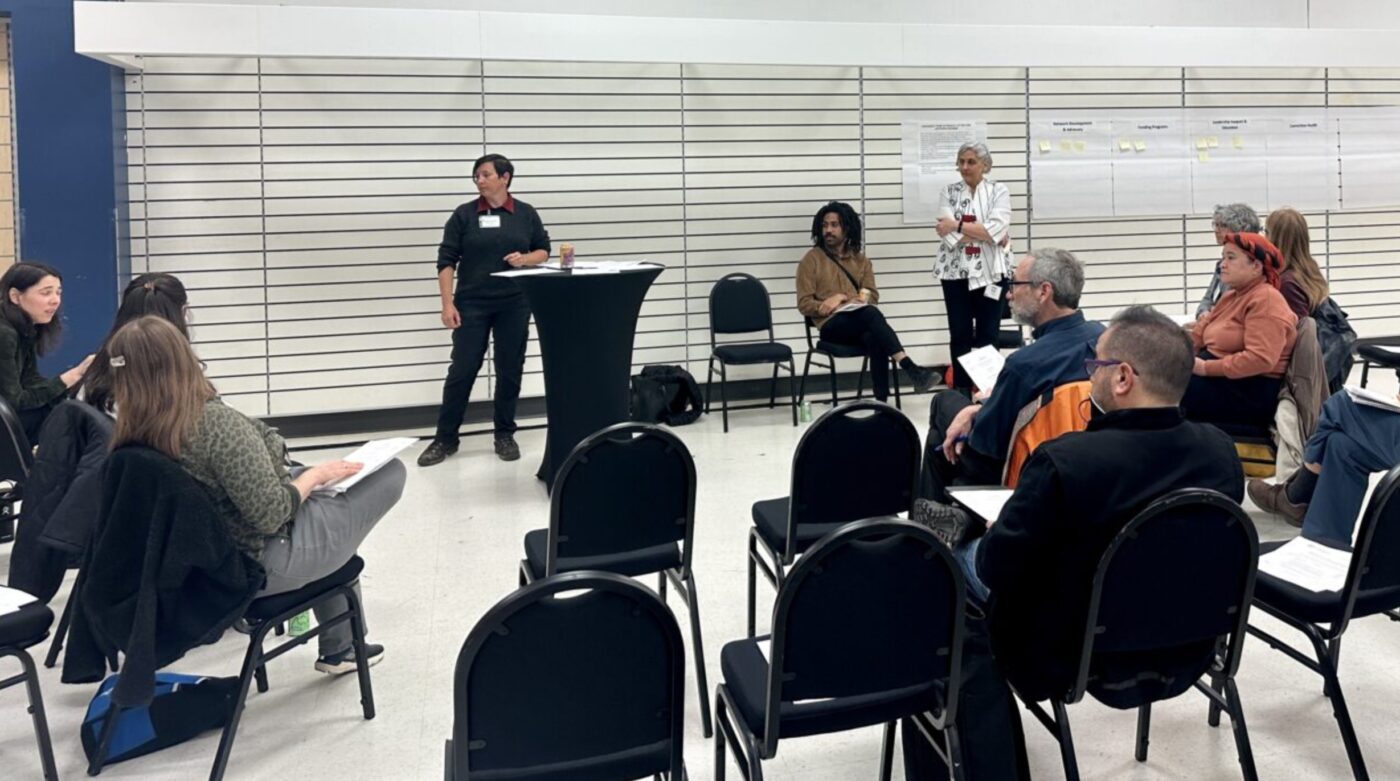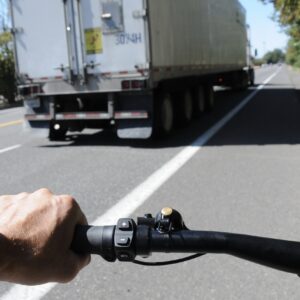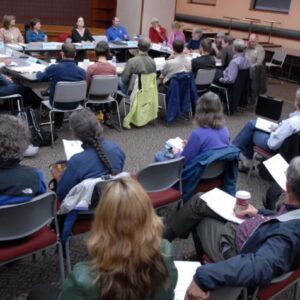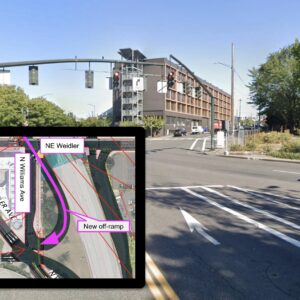
The Portland metro area is home to many transportation advisory committees. In addition to the City of Portland’s bicycle and pedestrian advisory committees, there are similar ones in other cities across the region, there are committees housed in Metro and Multnomah County, and dozens at the Oregon Department of Transportation.
This is the case throughout the entire state — from the coast to the high desert. But even though many of these groups are working toward similar goals, most of them are currently disconnected from one another. The Oregon Bicycle and Pedestrian Advisory Committee (OBPAC) wants to change that.
On Monday night, as part of The Street Trust’s Oregon Active Transportation Summit, members of OBPAC led a conversation between representatives from some of these different advisory groups. The conversation was conducted by Jessica Horning, the Oregon Department of Transportation’s Pedestrian and Bicycle Program Manager, and two OBPAC members: Beth Young, a planner in the City of Newport who serves as the committee’s local government/land use planning representative, and The Street Trust’s André Lightsey-Walker, an at-large member of the committee.
Meeting attendees included Joe Perez and Tiel Jackson, the respective co-chairs of Portland’s bicycle and pedestrian advisory committees; Emma Porricolo, a planner in the City of Canby; Multnomah County transportation planner MaryJo Andersen and Multnomah County Bicycle and Pedestrian Community Advisory Committee chair Andrew Holtz. Another attendee, David Philbrick, is a member of the Salem Bicycling Club looking to find more advocacy opportunities locally.
“These [bike and pedestrian advisory] programs don’t have a lot of resources,” Horning said. Most of the members on these active transportation committees are volunteers, whereas groups like the Mobility Advisory Committee (effectively Oregon’s freight advisory committee) are made up of experienced business owners who participate in committee work while on the clock.
To begin the discussion, Horning shared a bit about how OBPAC came to be. This committee was formed as the Oregon Bicycle Committee in 1973, shortly after the Oregon Bicycle Bill was passed. According to the statute recognizing this committee (ORS 366.112), the purpose of OBPAC is to “advise the department regarding the regulation of bicycle traffic and the establishment of bicycle lanes and paths.”
ODOT has a number of other advisory committees, that cover everything from motorcycle safety to public transit. But the influence these groups are able to exert varies. While the moneyed statewide freight advisory committee has demonstrated an ability to impact Oregon transportation plans according to their preferences, OBPAC hasn’t wielded that same power — and neither have other city or county active transportation advisory committees. (This is part of the reason the Portland Bureau of Transportation is looking to reform their modal committee structure.)
Still, OBPAC has more resources than a lot of the local advisory committees around the state, and there’s power in numbers and connectivity. Horning said OBPAC wants to be able to provide educational resources to people who volunteer on active transportation committees and might benefit from some extra training in order to create more effective advisory groups statewide.
“These [bike and pedestrian advisory] programs don’t have a lot of resources,” Horning said. Most of the members on these active transportation committees are volunteers, whereas groups like the Mobility Advisory Committee (effectively Oregon’s freight advisory committee) are made up of experienced business owners who participate in committee work while on the clock.
Even with the strong culture of transportation advocacy that exists in Portland, the city’s bicycle and pedestrian advisory committees struggle to get local officials to listen to them. You can imagine, then, what an uphill battle people in more suburban or rural communities without that same advocacy network or history of active transportation investment are dealing with. But people all across the state deserve to be able to walk and bike in their cities safely. This might be where OBPAC can step in as a leader.
So, what would advisory committee members like help with from OBPAC? Attendees had some ideas, which they wrote on sticky notes for the group to discuss. Here’s a selection of thoughts:
“Give guidance on how our BPAC [bicycle and pedestrian advisory committee] can get our city council to listen to us.”
“Tell BPACs across the state about new policies/regulations coming from the state (like the Climate Friendly Equitable Mobility program).”
“Bring experts and new innovation guest speakers to BPACs.”
“Help BPAC members understand their role in securing funding…keep a running list of current grant opportunities and basic info about
grants on OBPACs page.”
“Compile BPAC contacts and host info shares occasionally.”
One of the things that might limit OBPAC’s ability to preside over this work? People don’t trust ODOT, the agency where the committee is housed. (Even OBPAC members themselves have expressed feeling out of the loop about statewide bike and transportation projects.) Jackson voiced her concerns about this at the meeting.
“I can’t say I trust ODOT to support BPACs statewide,” Jackson said. “I don’t have that level of trust.”
Perhaps BPAC members will have to rely on each other, then — if they can find one another. Horning revealed that ODOT doesn’t track all the local advisory committees throughout the state, which will make collaboration difficult. The first step, then, is getting this information.
Horning said OPBAC plans to hold more listening sessions like this one in the future to further engagement with bicycle and pedestrian advisory committees statewide. If you’re a member of one of these organizations and want to connect, you can find more about OBPAC at their website.
This story is part of our coverage of the 2023 Oregon Active Transportation Summit. See more stories here.





Thanks for reading.
BikePortland has served this community with independent community journalism since 2005. We rely on subscriptions from readers like you to survive. Your financial support is vital in keeping this valuable resource alive and well.
Please subscribe today to strengthen and expand our work.
ODOT could, if they wanted to, require that all transportation projects of any type (including freeways) have to be approved and signed-off by the local bicycle/pedestrian advisory committee or commission before moving forward. Don’t have a biped commission? Get one.
From an official policy in British Columbia.
Apparently at first most of the BC BiPed committees were rubber stamp groups mostly made up of highway officials and other car-centric folks, but gradually the bike and ped folks took over each local commission.
I’m so skeptical of anything ODOT does with cycling and peds. ODOT is all about moving motor vehicles, in my experience.
All they are looking for is a citizen committee to sign off on their BS.
Compared to Ryan Sharp, the Hoboken transportation director, this is farcical. Just endless committees to “support support support” other committees with no real action plan to speak of? *How* is this ODOT offshoot going to make politicians pay attention to transportation advocates??? “Support?!” I appreciate the coverage of this summit because it’s exposing the echo chamber of advocates just talking to each other about the same things over and over, but it’s also exposing how little attention politicians give to real transportation quandaries, and how isolated we all become in cars. I will be using this information at the ballot for sure, so I guess in that way this summit is accomplishing something (and your coverage of it is, too, Taylor). Where is the political will to do something, anything to bring biking numbers up? I just don’t get it.